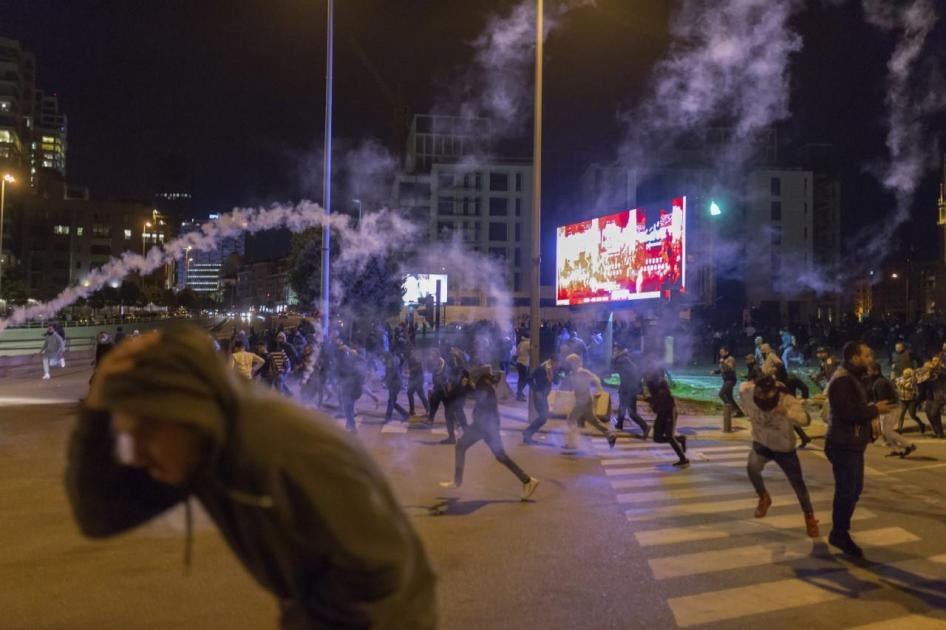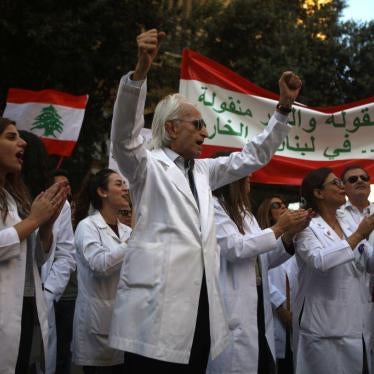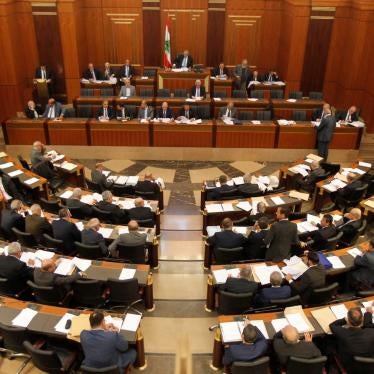(Beirut) – Lebanon’s security forces used excessive force against protesters, some of whom threw fireworks and rocks, during demonstrations in downtown Beirut on December 14 and 15, 2019, Human Rights Watch said today.
Security forces launched large quantities of teargas at protesters – not only to disperse them but also as they tried to leave, shot protesters with rubber bullets, and sprayed them with water cannons. Security forces also violently beat some protesters, causing serious injuries. Witnesses said that the Internal Security Forces’ Riot Police and the Parliament Police were responsible for the abuse, but the witnesses could not always distinguish between the two forces because they wear the same uniforms.
“Instead of addressing protesters’ very real grievances, Lebanon’s authorities deployed security forces who unnecessarily shot rubber bullets and teargas and beat protesters,” said Joe Stork, deputy Middle East director at Human Rights Watch. “For the public to have confidence in the investigations the Ministry of Interior claims are ongoing, there needs to be transparency around both the process and any resulting disciplinary measures.”
To minimize abuses, better coordination is needed between the multiple security agencies on the ground, including riot police, other Internal Security Forces units, the army, and units responsible for the security of parliament, Human Rights Watch said.
On the evenings of December 14 and 15, thousands of protesters gathered near Nejmeh Square to protest parliament’s likely re-nomination of Saad Hariri as prime minister. In a meeting with Human Rights Watch on December 17, Interior Minister Raya el-Hassan, acting in a caretaker capacity since the prime minister’s resignation on October 29, said that she had ordered an investigation into the violence on December 14 and had taken measures to prevent such violations from recurring, including clarifying chains of command between security forces.
The Riot Police are under the command of the Interior Minister while Parliament Police are under the command of the Speaker of Parliament, el-Hassan said. The Parliament Police has not released any public statements regarding accountability for its members’ abuses.
Human Rights Watch observed the protests on December 15 and interviewed nine protesters and two media workers who also witnessed the violence. Human Rights Watch interviewed five protesters and four media workers who were there on December 14. Most protesters asked not to be named. Although the army was deployed on December 15, they were not involved in the violations and their role was largely limited to ensuring that counterdemonstrators did not enter downtown Beirut.
Witnesses said that on December 14 at 6 p.m., about 1,000 people gathered at the Waygand Street entrance to Nejmeh Square, the site of the parliament. The Internal Security Forces’ Riot Police and Parliament Police were behind police barricades blocking the Nejmeh Square entrance.
Three witnesses said that the protests were overwhelmingly peaceful, but that at around 7 p.m., several protesters tried to remove the barricades. Witnesses said that almost immediately security forces broke through the barricades, beat protesters, and fired large amounts of teargas at the crowds. During the ensuing 8-hour clash, security forces fired teargas and rubber bullets, and beat protesters indiscriminately. They also used water cannons in efforts to break up the protest.
Witnesses said that when the security forces’ assault began, some protesters responded by throwing fireworks, water bottles, and rocks. Video footage also shows protesters hurling teargas canisters back at security forces.
The Lebanese Red Cross and the Civil Defense reported that they treated 87 injured people at the scene and transported 46 to hospitals. The Internal Security Forces said that 20 of their men were transported to hospitals as well as 3 officers injured.
On December 15, thousands of protesters gathered again at the entrance to Nejmeh Square, many wearing helmets, goggles, and gas masks. At around 8 p.m., Human Rights Watch observers saw some protesters throwing fireworks, water bottles, and rocks at the Riot Police and Parliament Police members. At about 9:30 p.m., security forces began to launch teargas and burst through the barricades. Throughout the night, in addition to using water cannons, security forces launched large amounts of teargas cannisters, fired rubber bullets, and hurled large rocks. Protesters threw rocks, fireworks, and teargas canisters back at security forces.
The Lebanese Civil Defense and Red Cross reported that they treated 117 injured people at the scene and transported 24 to nearby hospitals. The Internal Security Forces said that 27 police and 2 officers were injured as rocks, fireworks, and sharp objects were thrown at them.
Commanding officers of all security forces should issue clear guidelines on when and how teargas and other riot control equipment may be used, Human Rights Watch said. The United Nations Basic Principles on the Use of Force and Firearms provide that all use of force by law enforcement must be proportionate and should only be escalated if other measures to address a genuine threat have proved ineffective or have no likelihood of achieving the intended result.
When using force, law enforcement should exercise restraint and act proportionately, taking into account both the seriousness of the offense and the legitimate objective to be achieved. The Internal Security Forces code of conduct, adopted in 2011, says that: “Police members will not resort to the use of force unless it is necessary, proportionate and after exhausting all possible non-violent means, within the minimum extent needed to accomplish the mission.”
The chains of command of all security forces should ensure that law enforcement officials who used excessive force face disciplinary action, including criminal prosecution if appropriate. The Office of the Public Prosecutor should urgently open an independent investigation into the events that took place on December 14 and December 15 and make the results public, Human Rights Watch said.
To advance accountability efforts, members of different security forces should have clearly distinguishable uniforms. The various units and law enforcement officers should be identifiable, including through name tags or identification numbers on their uniforms. Investigations conducted into alleged security force abuses should be transparent and the findings made public.
“Lebanon’s security forces are obligated to abide by human rights standards for the use of force, including rubber bullets and teargas,” Stork said. “They failed to do that last weekend. Moving forward, all security forces should adhere to these standards to prevent unnecessary harm.”
The Government’s Response
During the meeting with Human Rights Watch on December 17, Interior Minister el-Hassan acknowledged that “mistakes were made,” and said that long working hours, exhaustion, stress, and lack of appropriate training contributed to the Riot Police abuses. She said that internal investigations into abuse by members of the Internal Security Forces were underway.
She also said that poor coordination between various security agencies led to confusion on chains of command and “unacceptable scenes” on December 14. She said she acted quickly to rectify this by making clear that forces under the Interior Ministry could not take orders from other security branches, specifically Parliamentary police, even if deployed together.
She said that Major General Imad Othman, the commander of the Internal Security Forces, has the authority to order the use of teargas and that she was not aware of clear criteria for the use of rubber bullets.
The Parliament Police did not respond to a request for comment on the events of December 14 and 15.
Use of Weapons
Although teargas is normally not a lethal weapon, it can cause serious medical problems even when used with restraint. As a riot control method, teargas should only be used where necessary as a proportionate response to quell violence. It should not be used in large quantities in confined spaces and narrow alleys. Canisters should not be fired directly at any individual, and never at close range. Where possible, security forces should warn demonstrators before firing teargas.
Based on United Nations guidance on the use of “less-lethal weapons,” kinetic impact projectiles like rubber bullets should “generally only be used in direct fire with the aim of striking the lower abdomen or legs of a violent individual and only with a view to addressing an imminent threat of injury to either a law enforcement official or a member of the public.” Water cannons “should only be used in situations of serious public disorder where there is a significant likelihood of loss of life, serious injury, or widespread destruction of property” and should not be used at short range.
December 14 Protests
Human Rights Watch interviewed four witnesses, who said that there were approximately 1,000 protesters, who were overwhelmingly peaceful and included many families and children. Three of the witnesses at the front lines said that at around 7 p.m., they saw a handful of protesters try to move barricades that the Internal Security Forces and Parliament Police had erected at the entrance of Nejmeh Square.
Almost immediately, they said, security forces broke through the barricades and began to beat people “left and right,” as one person put it. Within a few minutes, they said, security forces started to launch teargas canisters of teargas. “It was raining teargas from the get-go,” said a video journalist at the scene who said that many members of law enforcement fired teargas simultaneously, and counted 30 cannisters being fired within one minute.
One protester who was further back in the crowd said that at about 7 p.m.: “All of a sudden, we saw teargas coming out of nowhere, and a lot of it all at once. You saw people take off running and causing a stampede, but there were a lot of elderly and little kids… No one had protection because they weren’t expecting it.”
Witnesses said that security forces chased protesters down alleyways and beat them severely. The video journalist said he saw police beating women and old people recklessly: “I have footage of an officer kicking a girl, and of an older lady being beaten until she dropped to the ground… This was all in the first hour.”
A writer at the protest said she saw about eight security officers beating a young man. Shortly after, an officer hit her with a baton and then kicked her in the stomach.
Nada Homsy, a journalist, said: “Every corner I looked, there was someone getting beaten or arrested. It was apocalyptic.”
Legal Agenda, a local rights group, reported that security forces severely beat a young man from the northern Lebanese city of Tripoli on his head, causing him to lose consciousness for several hours and to suffer memory loss.
Two protesters captured security forces firing rubber bullets at protesters on video that Human Rights Watch reviewed. Four other protesters said that they heard the sound of rubber bullets being fired by security forces.
Witnesses said that when the security forces began their attack, some protesters responded by throwing fireworks, water bottles, and rocks at security forces. Video footage also shows protesters hurling teargas canisters back at security forces. The December 14 confrontation lasted almost eight hours, as security forces pushed protesters back from the entrance to Nejmeh Square toward the Annahar building and Martyrs’ Square and then further back toward the Kataeb Party headquarters. At around midnight, a witness said, Internal Security Forces began also to use water cannons to disperse protesters.
Witnesses said that they could not always distinguish between the Internal Security Forces’ Riot Police and the Parliament Police because they wear the same uniforms. According to LBC, a local television channel, Parliament Police have 412 members, 112 of whom are from the Internal Security Forces ranks. The rest are appointed directly by the Speaker of Parliament, Nabih Berri, and most are from his party, the Amal Movement.
The media channel reported that members of the Parliament Police are not bound by the same code of conduct, training, or command structures as other security forces, and the decision to promote members rests solely with the parliament speaker. They added that the Parliament Police’s budget is allocated from parliament’s budget.
December 15 Protests
On the evening of December 15, thousands of demonstrators gathered once more at the entrance to Nejmeh Square, protesting the excessive use of force the night before and rejecting the expected nomination of Hariri as prime minister. At around 8 p.m., Human Rights Watch observers saw protesters throwing fireworks, water bottles, and rocks toward the security forces. At around 9:30 p.m., security forces fired teargas and burst through the barricades. The observers saw police officers beating protesters and hurling rocks at them. A rock hit Mohammad Azakir, a Reuters photographer, in the face, injuring him.
Security forces fired many teargas canisters into the crowds and used water cannon to drive protesters back along Waygand street toward Martyrs’ Square and the Annahar building. The observers saw law enforcement officers chase protesters down narrow alleyways in downtown Beirut, beat them, and launched teargas. One protester posted photos on social media showing severe injuries, including on his head, that he alleged were the result of security force beatings. Human Rights Watch could not verify his account.
The video journalist who was there both days said that he saw security forces use rubber bullets, and also heard reports of their use, but more sparingly, on the second night. A protester from Tripoli said he saw four people with injuries, including two to their torsos from rubber bullets. The protestor also saw a protester with broken teeth, also sustained from police use of force. Another protester said that he saw two people injured by rubber bullets, one on his shoulder and the other at his waistline. Images and videos circulating on social media showed protesters’ with injuries from rubber bullets. Human Rights Watch could not independently verify those accounts.
At around 11 p.m., Human Rights Watch observers saw men dressed in black burning protesters’ tents in Martyrs’ Square. It was unclear who the men were, though two protesters said that they saw the men walk to the scene accompanied by uniformed law enforcement officers. Local media reported that Parliament Police were behind the attack.
Counterdemonstrators supporting the parliament speaker tried to attack protesters around 11:30 p.m. Human Rights Watch observed some protesters throwing fireworks and rocks at the counterdemonstrators, who were quickly repelled by the Lebanese Army, which had formed a perimeter around the downtown area to keep the counterdemonstrators out. Throughout the night, Human Rights Watch observers saw security forces using teargas to drive protesters back toward the Kataeb Party headquarters, while protesters tried to advance towards Martyrs’ Square and the Annahar building. Protesters threw rocks and teargas canisters back at security forces. Confrontations between protesters and security forces ended at around 1 a.m.
Arrests
Ayman Raad, a lawyer working with the Lawyers’ Committee for the Defense of Protesters, an ad hoc group of pro bono lawyers, told Human Rights Watch that the Internal Security Forces arrested 14 protesters during the confrontations on December 14, all of whom were released at noon the next day. On December 15, Raad said, the Internal Security Forces arrested eight protesters, and the army arrested one. All eight arrested by the ISF were released at 4 p.m. the next day.









